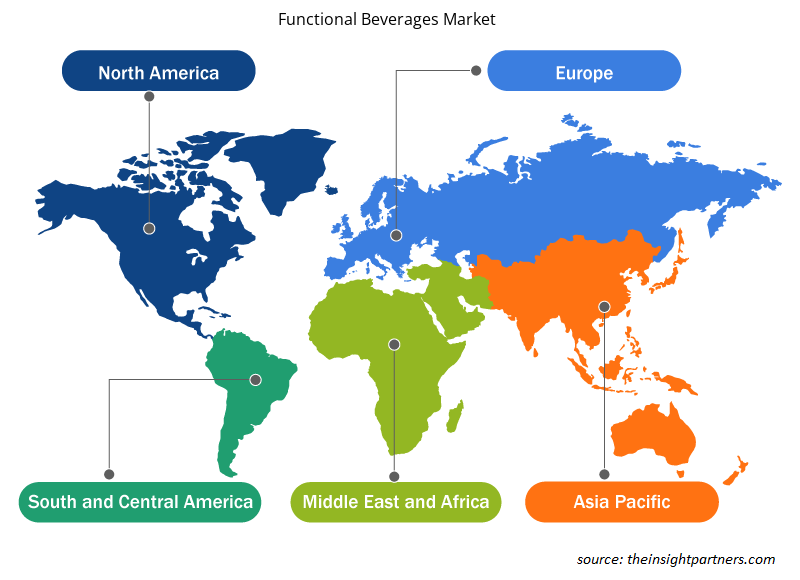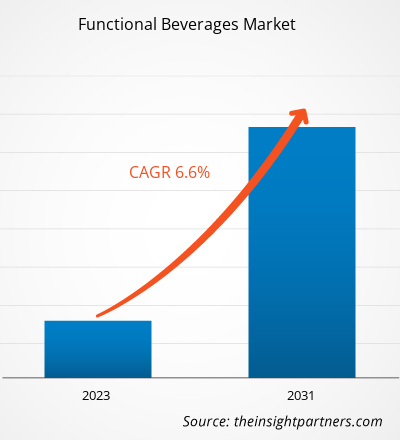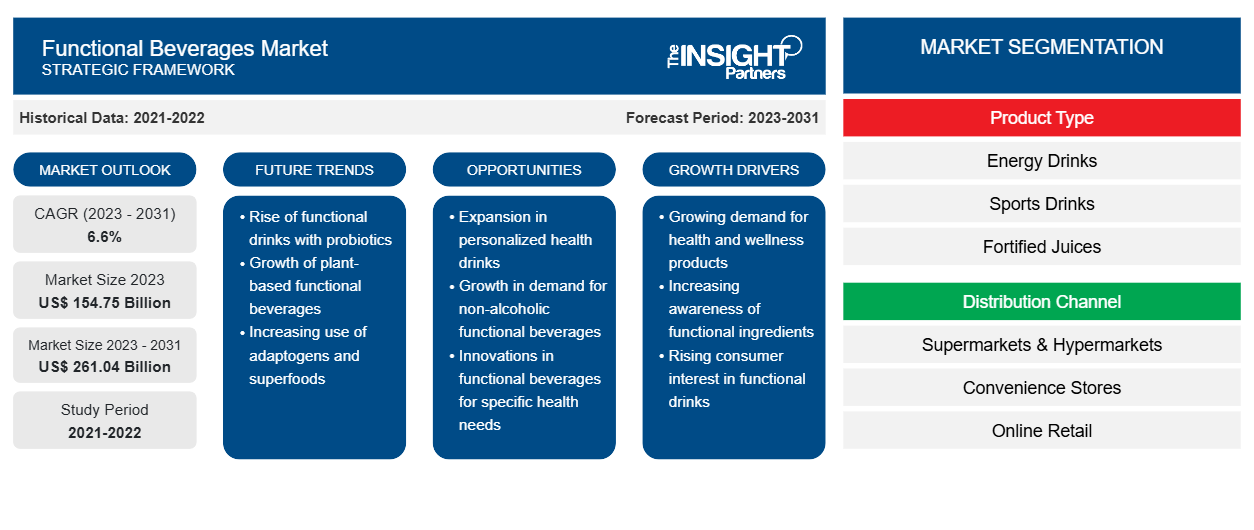Se proyecta que el tamaño del mercado de bebidas funcionales alcance los 261.040 millones de dólares estadounidenses en 2031, frente a los 154.750 millones de dólares estadounidenses en 2023. Se espera que el mercado registre una CAGR del 6,6 % durante el período 2023-2031. Es probable que la creciente conciencia sobre la salud siga siendo una tendencia clave en el mercado de bebidas funcionales.
Análisis del mercado de bebidas funcionales
El análisis del mercado de bebidas funcionales reveló un panorama dinámico y próspero impulsado por la evolución de las preferencias de los consumidores, los avances tecnológicos y las tendencias de salud y bienestar. La creciente conciencia de la salud entre los consumidores ha aumentado la demanda de bebidas que ofrecen beneficios funcionales más allá de la hidratación básica. Esto incluye bebidas fortificadas con vitaminas, minerales, antioxidantes, probióticos y otros ingredientes bioactivos para respaldar objetivos de salud específicos, como la mejora de la energía, el apoyo inmunológico, la salud digestiva y la reducción del estrés. Las tendencias del mercado indican un cambio hacia productos de etiqueta limpia con ingredientes naturales, procesamiento mínimo y transparencia en las prácticas de abastecimiento y fabricación.
Descripción general del mercado de bebidas funcionales
El mercado de las bebidas funcionales ha experimentado un crecimiento significativo en los últimos años debido a la creciente conciencia de los consumidores sobre los beneficios para la salud asociados a estas bebidas. Además de la hidratación básica, las bebidas funcionales también ofrecen beneficios adicionales para la salud, como una mayor energía, una mejor función cognitiva, inmunidad o control del peso. Estas bebidas están enriquecidas con vitaminas, hierbas, minerales u otros ingredientes para promover la salud y el bienestar. Uno de los factores clave que impulsa el crecimiento del mercado de las bebidas funcionales es la creciente demanda de soluciones de salud convenientes y para llevar. Los estilos de vida ajetreados y un enfoque creciente en el bienestar han llevado a los consumidores a buscar bebidas que no solo tengan buen sabor, sino que también brinden beneficios funcionales. Esta tendencia ha llevado al desarrollo de una amplia gama de bebidas funcionales, incluidas las bebidas energéticas, las bebidas deportivas, las aguas fortificadas y el té y el café listos para beber.
Personalice este informe según sus necesidades
Obtendrá personalización en cualquier informe, sin cargo, incluidas partes de este informe o análisis a nivel de país, paquete de datos de Excel, así como también grandes ofertas y descuentos para empresas emergentes y universidades.
-
Obtenga las principales tendencias clave del mercado de este informe.Esta muestra GRATUITA incluirá análisis de datos, desde tendencias del mercado hasta estimaciones y pronósticos.
Impulsores y oportunidades del mercado de bebidas funcionales
Aumentar la conciencia sobre la salud
El cambio hacia estilos de vida más saludables ha impulsado la demanda de bebidas funcionales que ofrezcan más que solo hidratación. Los consumidores buscan cada vez más bebidas que brinden beneficios adicionales para la salud, como vitaminas, minerales, antioxidantes, probióticos y otros ingredientes bioactivos. Estas bebidas funcionales se perciben como alternativas más saludables a las bebidas azucaradas tradicionales, en línea con las opciones de los consumidores conscientes de la salud que buscan mejorar su bienestar general. Las vitaminas y los minerales son nutrientes esenciales que apoyan varias funciones corporales, mientras que los antioxidantes ayudan a combatir el estrés oxidativo y la inflamación en el cuerpo. Por otro lado, los probióticos promueven la salud intestinal y la digestión al introducir bacterias beneficiosas en el sistema digestivo.probiotics, and other bioactive ingredients. These functional beverages are perceived as healthier alternatives to traditional sugary drinks, aligning with the choices of health-conscious consumers looking to improve their overall well-being. Vitamins and minerals are essential nutrients that support various bodily functions, while antioxidants help combat oxidative stress and inflammation in the body. On the other hand, probiotics promote gut health and digestion by introducing beneficial bacteria to the digestive system.
Creciente interés por el bienestar y el cuidado personal
El creciente interés por el bienestar y el cuidado personal ha influido significativamente en las preferencias de los consumidores, lo que ha provocado un aumento de la demanda de bebidas funcionales diseñadas para apoyar objetivos de salud específicos. Ya sea para aumentar los niveles de energía, fortalecer el sistema inmunológico, promover la salud digestiva, controlar el peso o reducir el estrés, los consumidores buscan bebidas que ofrezcan beneficios funcionales específicos alineados con sus objetivos de bienestar.
Análisis de segmentación del informe de mercado de bebidas funcionales
Los segmentos clave que contribuyeron a la derivación del análisis del mercado de bebidas funcionales son el tipo de producto y el canal de distribución.
- Según el tipo de producto, el mercado de bebidas funcionales se segmenta en bebidas energéticas, bebidas deportivas, jugos fortificados, agua funcional y otros. El segmento de bebidas energéticas tuvo la mayor participación de mercado en 2023.
- Según el canal de distribución, el mercado de bebidas funcionales se segmenta en supermercados e hipermercados , tiendas de conveniencia, venta minorista en línea y otros. El segmento de supermercados e hipermercados tuvo la mayor participación de mercado en 2023.
Análisis de la cuota de mercado de bebidas funcionales por geografía
El alcance geográfico del informe del mercado de bebidas funcionales se divide principalmente en cinco regiones: América del Norte, Asia Pacífico, Europa, Medio Oriente y África, y América del Sur/América del Sur y Central.
El mercado de bebidas funcionales de América del Norte está creciendo de manera destacada debido al aumento de la población y al auge de la industria de alimentos y bebidas. El creciente número de personas preocupadas por la salud y la forma física en América del Norte ha aumentado la demanda de productos funcionales, lo que afecta a todos los elementos del menú; la categoría de bebidas ofrece la mayor oportunidad para la innovación en cuanto a sabores. Además, la popularidad de los refrescos y las bebidas de origen vegetal sin calorías, sin azúcar y bajos en carbohidratos está creciendo en toda la región, lo que impulsa el mercado de bebidas funcionales. Además, la creciente población vegana y la creciente tendencia al veganismo están impulsando la demanda de bebidas funcionales de origen vegetal, como la leche vegetal.
Perspectivas regionales del mercado de bebidas funcionales
Los analistas de Insight Partners explicaron en detalle las tendencias y los factores regionales que influyen en el mercado de bebidas funcionales durante el período de pronóstico. Esta sección también analiza los segmentos y la geografía del mercado de bebidas funcionales en América del Norte, Europa, Asia Pacífico, Oriente Medio y África, y América del Sur y Central.

- Obtenga datos regionales específicos para el mercado de bebidas funcionales
Alcance del informe de mercado de bebidas funcionales
| Atributo del informe | Detalles |
|---|---|
| Tamaño del mercado en 2023 | US$ 154,75 mil millones |
| Tamaño del mercado en 2031 | US$ 261.04 mil millones |
| CAGR global (2023 - 2031) | 6,6% |
| Datos históricos | 2021-2022 |
| Período de pronóstico | 2023-2031 |
| Segmentos cubiertos |
Por tipo de producto
|
| Regiones y países cubiertos |
América del norte
|
| Líderes del mercado y perfiles de empresas clave |
|
Densidad de actores del mercado de bebidas funcionales: comprensión de su impacto en la dinámica empresarial
El mercado de bebidas funcionales está creciendo rápidamente, impulsado por la creciente demanda de los usuarios finales debido a factores como la evolución de las preferencias de los consumidores, los avances tecnológicos y una mayor conciencia de los beneficios del producto. A medida que aumenta la demanda, las empresas amplían sus ofertas, innovan para satisfacer las necesidades de los consumidores y aprovechan las tendencias emergentes, lo que impulsa aún más el crecimiento del mercado.
La densidad de actores del mercado se refiere a la distribución de las empresas o firmas que operan dentro de un mercado o industria en particular. Indica cuántos competidores (actores del mercado) están presentes en un espacio de mercado determinado en relación con su tamaño o valor total de mercado.
Las principales empresas que operan en el mercado de bebidas funcionales son:
- PepsiCo
- La Compañía Coca-Cola
- Estar protegido
- La empresa Kraft Heinz
- Molinos generales, Inc.
- Danone SA
Descargo de responsabilidad : Las empresas enumeradas anteriormente no están clasificadas en ningún orden particular.

- Obtenga una descripción general de los principales actores clave del mercado de bebidas funcionales
Noticias y desarrollos recientes del mercado de bebidas funcionales
El mercado de bebidas funcionales se evalúa mediante la recopilación de datos cualitativos y cuantitativos a partir de investigaciones primarias y secundarias, que incluyen publicaciones corporativas importantes, datos de asociaciones y bases de datos. A continuación, se incluye una lista de los avances en el mercado de bebidas funcionales:
- Tropicana Products Inc. lanzó dos nuevos sabores de batidos con vitamina C. Los batidos de piña y mango y de fresa y plátano de Tropicana se venderán en toda la India en todos los canales de distribución que operan en el mercado. (Fuente: Tropicana, Noticias, 2023)
- Dole Packaged Foods anunció el lanzamiento de 11 nuevos productos. Se prevé que esta transformación esté impulsada por un nuevo equipo de liderazgo en Norteamérica compuesto por cuatro mujeres, una combinación de ejecutivas recientemente contratadas y con experiencia, con una sólida trayectoria y experiencia en las áreas de desarrollo de marca y productos. (Fuente: Dole, sitio web, 2023)
Informe de mercado sobre bebidas funcionales: cobertura y resultados
El informe "Tamaño y pronóstico del mercado de bebidas funcionales (2021-2031)" proporciona un análisis detallado del mercado que cubre las siguientes áreas:
- Tamaño del mercado y pronóstico a nivel global, regional y nacional para todos los segmentos clave del mercado cubiertos bajo el alcance
- Dinámica del mercado, como impulsores, restricciones y oportunidades clave
- Principales tendencias futuras
- Análisis detallado de las cinco fuerzas de Porter y PEST y FODA
- Análisis del mercado global y regional que cubre las tendencias clave del mercado, los principales actores, las regulaciones y los desarrollos recientes del mercado.
- Análisis del panorama de la industria y de la competencia que abarca la concentración del mercado, el análisis de mapas de calor, los actores destacados y los desarrollos recientes
- Perfiles detallados de empresas
- Análisis histórico (2 años), año base, pronóstico (7 años) con CAGR
- Análisis PEST y FODA
- Tamaño del mercado, valor/volumen: global, regional y nacional
- Industria y panorama competitivo
- Conjunto de datos de Excel
Informes recientes
Testimonios
Razón para comprar
- Toma de decisiones informada
- Comprensión de la dinámica del mercado
- Análisis competitivo
- Información sobre clientes
- Pronósticos del mercado
- Mitigación de riesgos
- Planificación estratégica
- Justificación de la inversión
- Identificación de mercados emergentes
- Mejora de las estrategias de marketing
- Impulso de la eficiencia operativa
- Alineación con las tendencias regulatorias























 Obtenga una muestra gratuita para - Mercado de bebidas funcionales
Obtenga una muestra gratuita para - Mercado de bebidas funcionales